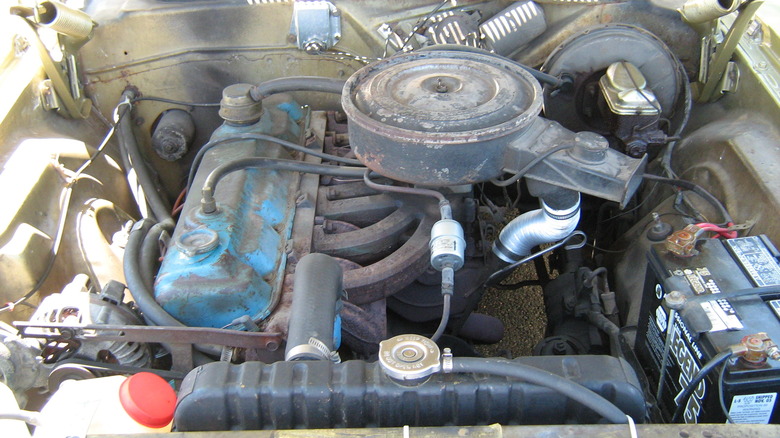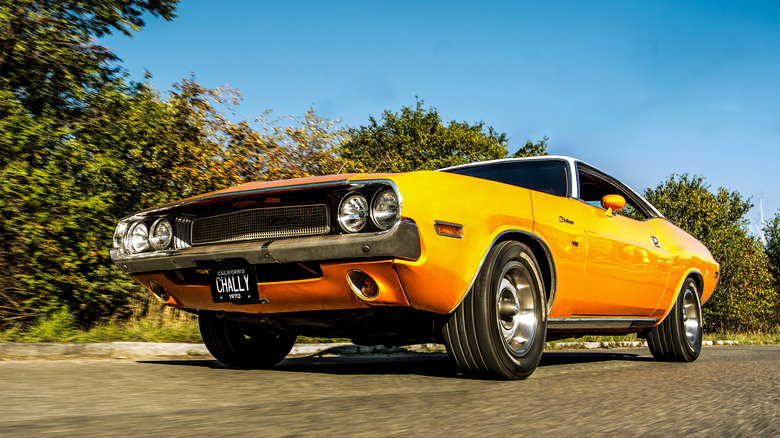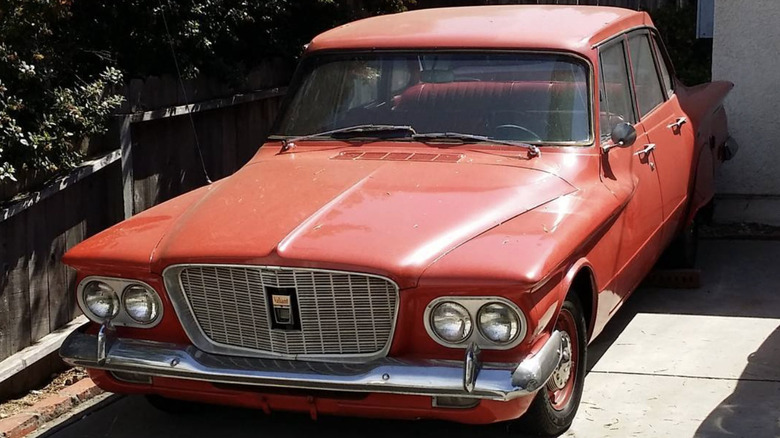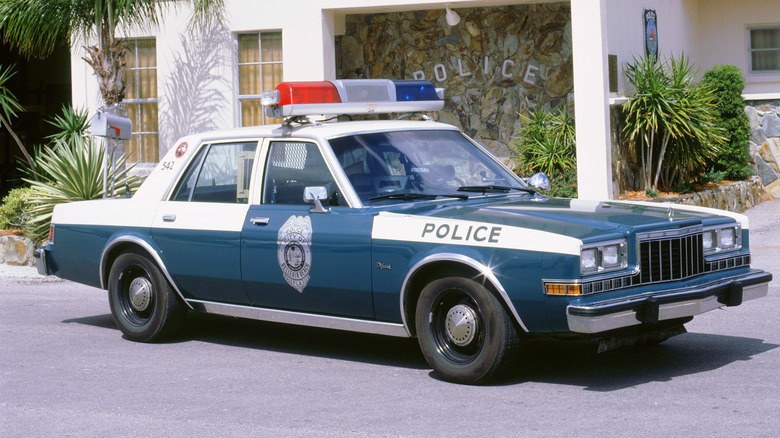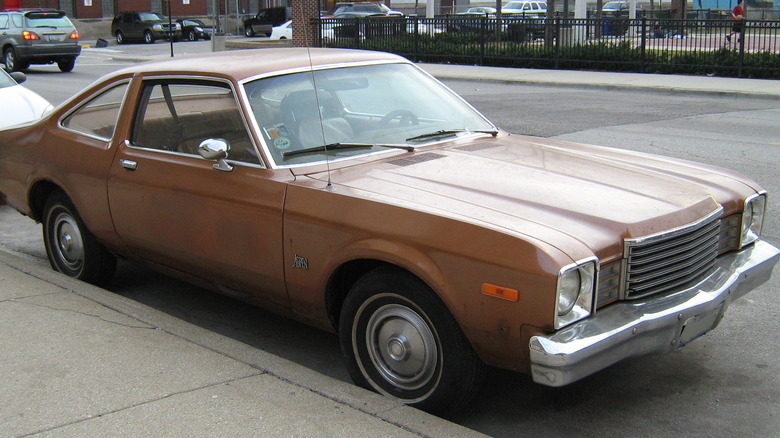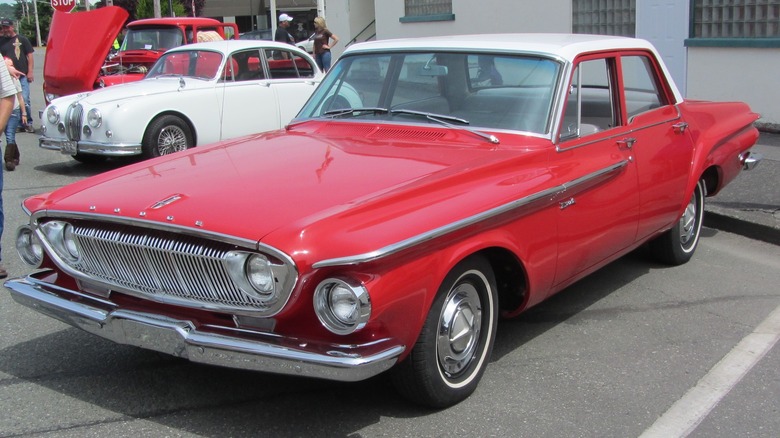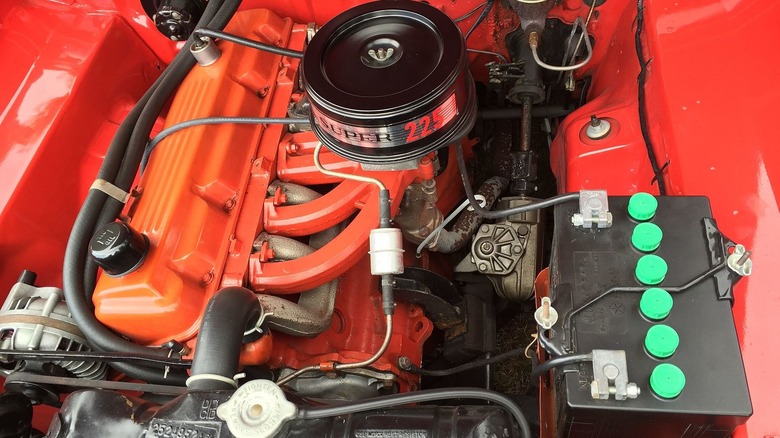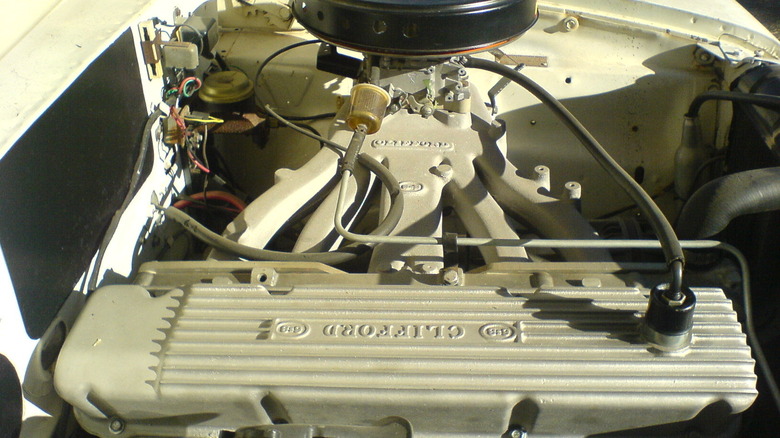Every Chrysler Slant-6 Engine Ranked From Worst To Best
The history of automotive engine development is long and varied, from the single-cylinder gas engine that powered the Patent Motorwagen in the 19th century to the 500-plus horsepower electric motor in the 2022 Porsche Taycan GTS. In between those two bookends, automakers have mainly concentrated on producing gasoline and diesel-powered engines that maximize efficiency and reliability with varying degrees of success.
Chrysler began as the Maxwell Motor Company in 1913, and Walter P. Chrysler took over as president in 1925 and rebranded the company in his name. He quickly expanded the enterprise, purchasing Dodge and introducing the Plymouth label within a few years. In the 1960s, Chrysler became a muscle car force, producing pavement-gobbling monsters like the Plymouth Roadrunner and Barracuda, Chrysler 300, and Dodge Challenger. Chrysler introduced the 170 cubic inch slant six engine in the 1960 Plymouth Valiant and a 225 cubic inch version in larger models.
The slant six got its name from the 30-degree angle necessary to fit the motor in the Valiant's small engine bay. It remained in use in various Mopar car models until 1984 and U.S.-based Dodge trucks through 1987. During that time, Chrysler issued many variations of the slant six in different displacements and with a variety of carburetors and emissions control systems. Let's look at each version of this durable engine and rank them from least to most desirable.
The slant six also found its way into boats, tractors, and a wide range of farm and industrial equipment, but for this article, we will stick to the versions Chrysler used in the cars and trucks of its various brands.
[Featured image by CZmarlin via Wikimedia Commons | Cropped and scaled | Public domain]
7. The 198
The weakest variation of the Chrysler slant six is not the smallest but rather the 198 cubic inch version that replaced the 170 cubic inch original in 1970. In its first two years of production, the 198 put out a respectable 125 horsepower and 180 pound-feet of torque, but the dawn of emissions control regulations led to power-sapping updates in the following years. The 1973 and 1974 198 cubic inch motors put out just 95 horsepower and 150 pound-feet or less of torque, versus the 101 horsepower and 155 pound-feet of the very first 170 cubic inch slant sixes.
The 198 engines can be found in early '70s models such as the 1970 and 1971 Dodge Challenger and Plymouth Barracuda coupes, but by 1975, the 198 had been phased out in favor of the 225. Unfortunately, the federally mandated addition of catalytic converters meant those mid-'70s 225 cubic inch slant sixes weren't any more powerful than their just-retired older siblings.
6. The original 170
Chrysler's next most desirable slant six is the original 170 cubic inch version that first appeared under the crested hood of the 1960 Valiant. It was engineered as a replacement for the flathead straight six, which had been in use since 1929. The engine tilt was the result of brainstorming by engineers who were trying to fit Chrysler's newest motor in the engine bay of the Valiant, a car Chrysler had designed in response to the American public's increasing demand for smaller vehicles.
The earliest 170s produced 101 horsepower and 155 pound-feet of torque, not terribly impressive benchmarks but enough to haul the Valiant up to a top speed of 89 mph. The 170 remained in production for a decade, after which it was replaced by the 198. Despite having a lower power output than the 170, the 198 is the favored engine today because many of its internal components are interchangeable with the 225 cubic inch versions of the slant six.
5. Electronically controlled 225 (1979–1987)
Flipping pages on the calendar usually brings welcome advances in engine technology, but in the case of the 225 cubic inch Chrysler slant six, the most modern versions are among the most troublesome. In 1981, Chrysler abandoned the tried-and-true Carter BBS and Holley 1920/1945 model carburetors for the electronic feedback Holley 6145, which had a built-in oxygen sensor that helped adjust the fuel mixture while the motor was cold or under stress. The system was temperamental and unnecessarily complicated, and subsequent attempts to add an engine control computer only added to the chaos.
These needless geegaws also introduced hard-to-trace vacuum leaks into the 225's ecosystem, and the difficulties in troubleshooting issues with the engine electronics undoubtedly hastened the demise of the slant six in the mid-'80s. The last cars to get the 225 slant six were the 1984 Chrysler Fifth Avenue, Plymouth Gran Fury, and Dodge Diplomat, many of which ended up in police and taxicab fleets. Dodge trucks could be purchased with the 225 through the 1987 model year.
4. Late '70s 225
Gearheads everywhere are familiar with the expression, "There's no replacement for displacement." The idiom that claims increasing an engine's size is always an improvement must have been crafted after 1975 when the 225 cubic inch slant six replaced the 198. Emerging emissions standards hobbled the 225's dyno numbers, and the oil crisis shifted consumer focus from performance to fuel economy at a time when fuel rationing was common. The 1975 version of the 225 cubic inch slant six only produced 95 horsepower and 170 pound-feet of torque, although that peak torque output came at just 1,600 rpm.
The new emissions standards also required a change from mechanical to hydraulic valve lifters, and the 225's forged steel crankshaft was redesigned and then replaced with a cast-iron version in 1976. In 1979, Chrysler began using aluminum intake manifolds on 225 cubic inch engines, but these manifolds were prone to warping and cracking. Soon after the aluminum manifolds were phased out came another unwelcome series of so-called upgrades to the 225.
[Featured image by CZMarlin via Wikimedia Commons | Cropped and scaled | Public domain]
3. Aluminum block 225
Years before Chrysler put a flimsy aluminum intake manifold on the 225 and loaded the top end with a maze of superfluous vacuum hoses and wiring, the automaker attempted to make the slant six leaner by casting the block from aluminum. Chrysler also developed and considered using an aluminum head as well, but this concept never made it past the testing stage. The lightweight blocks were reinforced with cast iron cylinder liners and topped with a specially designed head that had slightly smaller chambers placed closer together than those intended for iron blocks. The updated head design was carried over to all 225 engines beginning in 1963.
The shift to aluminum blocks required a significant investment in new factory machinery, and Chrysler produced about 50,000 aluminum block 225-powered vehicles in 1961 and 1962. While those numbers seem robust, the retooling wasn't sufficient to keep up with customer demand and Chrysler's projected needs, and production shifted back to exclusively cast iron blocks after the 1962 model year.
[Featured image by John Lloyd via Wikimedia Commons | Cropped and scaled | CC BY 2.0]
2. Super Six
American car buyers grew weary of 1970s emissions regulations that ultimately restricted air flow and sapped the 225 of its strength; from 1960 through 1963, the 225 put out 145 horsepower and 215 pound-feet of torque, but by 1976, those numbers had dropped to 100 horsepower and 170 pound-feet. In 1977, Chrysler responded by introducing the Super Six, which replaced the standard Holley 1945 one-barrel carburetor with a Carter BBD two-barrel model and matching intake manifold and air cleaner housing.
The upgraded carb boosted output to close to 1960s levels without an adverse effect on fuel economy, partially because Chrysler made the idle adjustment screws relatively inaccessible to prevent owners from tinkering with the carb's tuning. Mopar Connection Magazine upgraded a 1967 Dodge Dart to the Super Six package and reported "a noticeable improvement in the idle quality, the off-idle performance, the engine's cruising attributes, and the acceleration of the vehicle."
[Featured image by CZmarlin via Wikimedia Commons | Cropped and scaled | CC BY-SA 4.0]
1. Hyper Pak 225
Long before emissions regulations had sucked much of the slant sixes performance out through a rat's nest of vacuum hoses, Chrysler introduced a Hyper Pak version of the 225 meant to satisfy racing sanctioning bodies that required cars to be stock versions of commercially available models. The Hyper Pak included a four-barrel carburetor and intake, an upgraded cam and pistons, and a newly designed exhaust header.
The Hyper Pak system was available on 1961 and 1962 Plymouth Valiant and Dodge Lancer models and improved the 225's output to 196 horsepower, enough to rival many V8 engines of the era. The system was also available for 170 cubic inch engines and boosted the output of the smaller motor from 101 to 148 horsepower.
Clifford Performance used to sell an aftermarket Hyper Pak kit, and in 2003, Motor Trend put that kit on an aluminum block 225 and ended up with an engine that produced 231 horsepower and 280 pound-feet of torque: "Whether using a rare aluminum block or a common-as-nails iron block, if you follow our recipe, you'll have a car that idles at 900 rpm, runs great in traffic, delivers decent fuel economy, handles well, and blows minds when you mash the gas pedal and the rear skins explode in a cloud of tire smoke."
[Featured image by Brother Dave Thompson via Wikimedia Commons | Cropped and scaled | Public domain]
